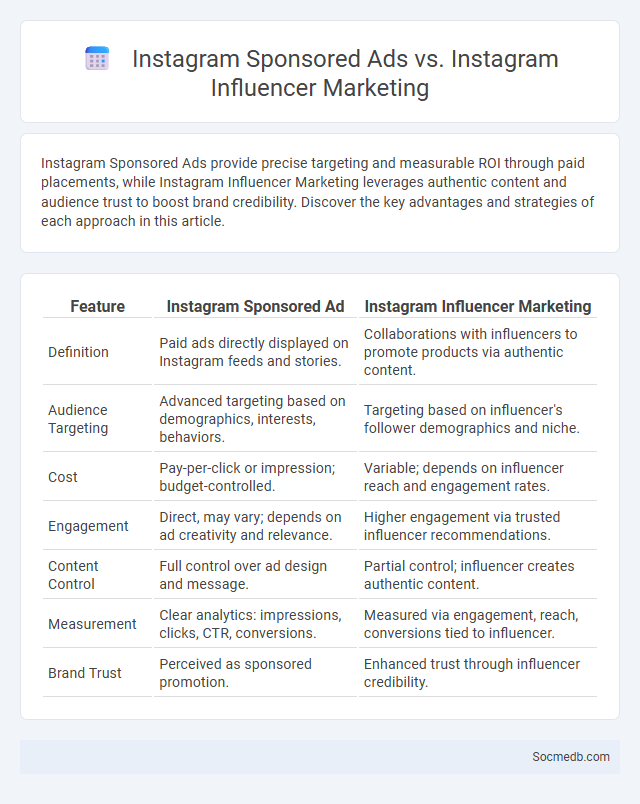
Photo illustration: Instagram Sponsored Ad vs Instagram Influencer Marketing
Instagram Sponsored Ads provide precise targeting and measurable ROI through paid placements, while Instagram Influencer Marketing leverages authentic content and audience trust to boost brand credibility. Discover the key advantages and strategies of each approach in this article.
Table of Comparison
| Feature | Instagram Sponsored Ad | Instagram Influencer Marketing |
|---|---|---|
| Definition | Paid ads directly displayed on Instagram feeds and stories. | Collaborations with influencers to promote products via authentic content. |
| Audience Targeting | Advanced targeting based on demographics, interests, behaviors. | Targeting based on influencer's follower demographics and niche. |
| Cost | Pay-per-click or impression; budget-controlled. | Variable; depends on influencer reach and engagement rates. |
| Engagement | Direct, may vary; depends on ad creativity and relevance. | Higher engagement via trusted influencer recommendations. |
| Content Control | Full control over ad design and message. | Partial control; influencer creates authentic content. |
| Measurement | Clear analytics: impressions, clicks, CTR, conversions. | Measured via engagement, reach, conversions tied to influencer. |
| Brand Trust | Perceived as sponsored promotion. | Enhanced trust through influencer credibility. |
Introduction to Instagram Marketing Strategies
Instagram marketing strategies leverage visual storytelling and targeted advertising to enhance brand visibility and engagement. Utilizing features like Instagram Stories, Reels, and Shopping allows you to connect with your audience authentically and drive conversions. Consistent content optimization and data analysis are essential to refine your approach and maximize ROI on this dynamic social platform.
What is Instagram Sponsored Ad?
Instagram Sponsored Ads are paid promotional posts displayed in users' feeds or stories, designed to increase brand visibility and engagement. These ads use advanced targeting options such as demographics, interests, and behaviors to reach specific audiences effectively. Businesses leverage Instagram Sponsored Ads to drive website traffic, boost conversions, and enhance brand awareness within the platform's 2 billion monthly active users.
Understanding Instagram Influencer Marketing
Instagram influencer marketing leverages individuals with substantial followings to promote brands, products, or services through authentic, engaging content. Key metrics for understanding influencer impact include engagement rate, follower growth, and content reach, which directly affect campaign effectiveness and ROI. Brands target influencers based on niche relevance, audience demographics, and content style to maximize brand awareness and consumer trust on Instagram.
Sponsored Ad: Definition and Scope
Sponsored ads on social media platforms are paid advertisements designed to increase brand visibility and target specific audiences based on demographics, interests, and behaviors. They appear seamlessly in users' feeds, stories, or sidebars, blending with organic content to boost engagement and conversions. Marketers utilize advanced targeting tools and analytics within platforms like Facebook, Instagram, and LinkedIn to optimize ad delivery and measure campaign effectiveness.
Key Differences: Sponsored Ad vs. Influencer Marketing
Sponsored ads provide direct control over messaging, targeting specific demographics using platform algorithms to maximize reach and conversions. Influencer marketing leverages the credibility and authentic connection influencers have with their audience, creating content that feels organic and trustworthy. Your brand benefits from measurable ad performance data with sponsored ads, while influencer campaigns drive engagement through personal endorsements.
Targeting and Audience Reach Comparison
Social media platforms offer diverse targeting options such as demographics, interests, and behaviors, enabling precise audience segmentation to maximize campaign effectiveness. Facebook and Instagram provide extensive reach with detailed targeting tools, while LinkedIn focuses on professional demographics, ideal for B2B marketing. Understanding these differences allows you to tailor your strategy, optimizing audience reach and engagement across platforms.
Cost Effectiveness: Instagram Sponsored Ad vs. Influencer Marketing
Instagram sponsored ads offer precise targeting options and measurable ROI, often delivering cost-effective results for specific campaigns. Influencer marketing, while potentially more expensive, can generate authentic engagement and brand trust by leveraging the influencer's loyal audience. Brands allocating budget should analyze conversion rates and audience relevance to optimize spend between these two social media strategies.
Engagement and Conversion Rates Analysis
Analyzing engagement and conversion rates on social media involves tracking metrics like click-through rates, shares, comments, and time spent on content to assess audience interaction. Your ability to interpret this data helps optimize campaigns, targeting the most effective content to boost user actions such as purchases or sign-ups. Leveraging tools like Google Analytics and platform-specific insights enhances the accuracy of conversion tracking and overall campaign performance.
Brand Suitability: Which Strategy to Choose?
Brand suitability on social media requires selecting a strategy aligned with your company's values, target audience, and content preferences to maximize engagement and safeguard reputation. Your approach should involve rigorous audience analysis, platform-specific content tailoring, and continuous monitoring of ad placements to avoid associations with inappropriate or conflicting content. Implementing advanced brand safety tools and partnering with trusted platforms enhances your ability to maintain brand integrity and achieve measurable marketing outcomes.
Conclusion: Maximizing ROI with the Right Approach
Maximizing ROI in social media requires a strategic approach tailored to your target audience and business goals. Leveraging data analytics and continuous optimization ensures your campaigns deliver measurable results and higher engagement. Your investment will yield greater returns by focusing on relevant platforms and content that resonate with your audience.
 socmedb.com
socmedb.com